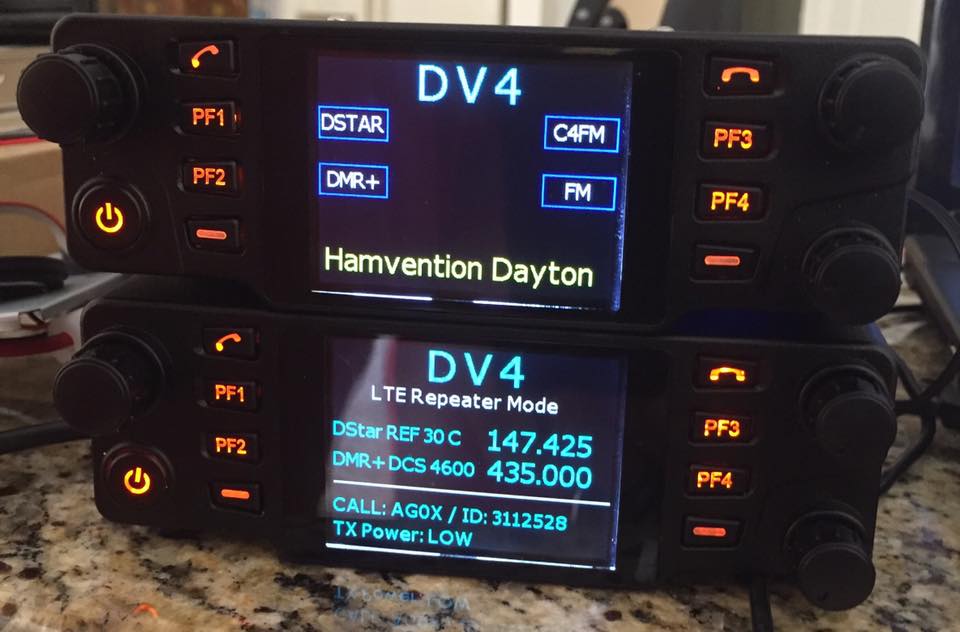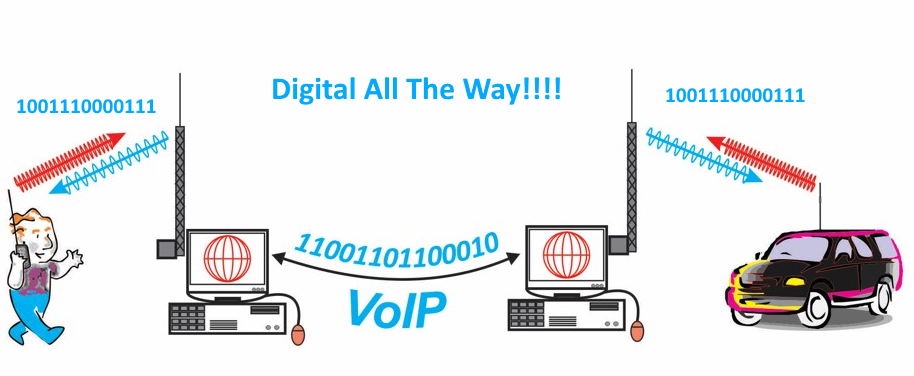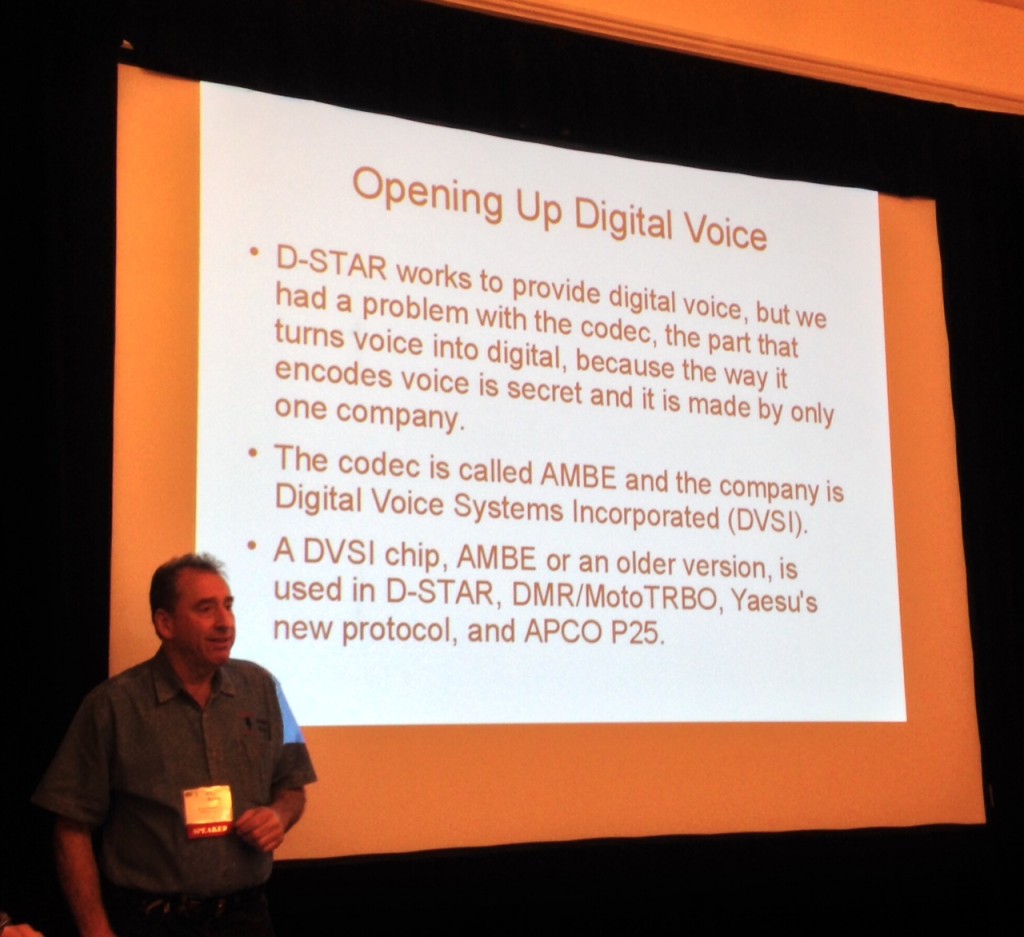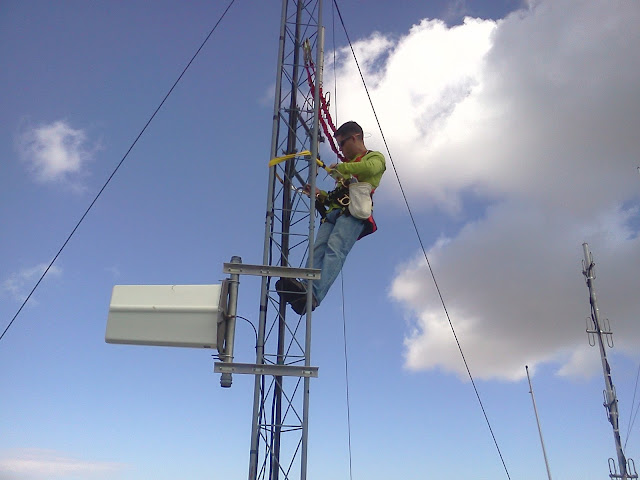Posts Tagged ‘D-Star’
 The Cacophony of Digital Voice Continues (Part 1)
The Cacophony of Digital Voice Continues (Part 1)
It wasn’t that long ago that I commented on the state of digital voice on the VHF/UHF ham bands: Digital Voice Balkanization. We have three main competing (incompatible) standards in the running: D-STAR, DMR and Yaesu System Fusion (YSF). At a high level, these three formats all do the same thing but there are significant differences in implementation (See Comparison of Amateur Radio DV by Roland Kraatz W9HPX.) All three of these are (arguably) open standards, allowing anyone to implement equipment that supports the standard. However, the reality is that D-STAR is still largely an ICOM system (with Kenwood joining the party), YSF is mostly a Yaesu system and DMR is…well, DMR is not deeply embraced by any large amateur radio equipment supplier. Instead, DMR is promoted heavily by Motorola for the commercial market via their MOTOTRBO product line. Another big factor is the availability of DMR radios from some of the low cost providers in the ham market: Connect Systems, Tytera MD-380. Baofeng has also announced a DMR radio but it has some potential shortcomings.
D-STAR has a clear head start versus the other DV standards and is well-entrenched across the US and around the world. DMR and YSF are the late comers that are quickly catching up. To put some numbers on the adoption of DV technology, I took at the digital repeater listings in the August issue of the SERA Repeater Journal. SERA is the coordinating body for Georgia, Kentucky, Mississippi, North Carolina, South Carolina, Tennessee, Virginia and West Virginia. This is a large region that includes rural and large urban areas, so perhaps it is a good proxy for the rest of the country. I just considered the listings for D-STAR, DMR and YSF repeaters, some of which are set up as mixed-mode analog and digital repeaters.
D-STAR 161 39% DMR 136 33% YSF 121 29% Total: 418 100% SERA Repeater Journal - August 2016
I was definitely surprised at how the DMR and YSF numbers are in the ballpark with D-STAR. Of course, we don’t know for sure how many of these repeaters are actually on the air or how many users are active on each one. Still, pretty impressive numbers. (And I did not bother to count the analog FM repeaters but those numbers are way higher, of course.)
It is the repeater clubs and repeater owners that drive the deployment of infrastructure for new technology. To some extent, they are driven by what their users want but also by their own technical interests and biases. One of the positive factors for DMR is that most of these systems are Motorola MOTOTRBO. Hams involved in commercial land mobile radio are exposed to that technology and naturally port it into the amateur radio world. MOTOTRBO is actually not that expensive and it’s built for commercial use. YSF received a big boost when Yaesu offered their repeater for $500 to clubs and owners that would put them on the air. By using Yaesu’s mixed analog/digital mode, it was an easy and attractive upgrade for aging repeater equipment.
Disruption From New Players
Early on in the world of D-STAR, the DV Dongle and DV Access Point by Robin AA4RC allowed hams to access the D-STAR network without needing a local repeater. This basic idea has continued and evolved in several different directions. For example, the DV4Mini is a cute little USB stick that implements a hot spot for…wait for it…D-STAR, DMR and YSF. This is very affordable technology (darnright cheap) that lets any ham develop his or her own local infrastructure. We don’t need no stinkin’ repeater. DV MEGA is another hot spot, supporting D-STAR, DMR and YSF. I guess somebody forgot to tell these guys they have to choose one format and religiously support only that one.

OK, so that’s one way to solve the babel fish problem…support all three formats in one device. And that’s what the DV4 mobile radio promises to do as well: “This DV4mobile is a tri-band VHF/UHF transceiver (2m, 1.25m and 70cm) that supports DMR, D-STAR and C4FM ( or “fusion”) all in one box.” Heck, let’s throw in LTE while we are at it, it’s only software. This site says the radio will be available Q4 2016. Well, it’s Q4, so maybe it will be here soon.
Conclusions
So let’s wrap up Part 1 of this story. What can we conclude?
- For the foreseeable future, we will have D-STAR, DMR and YSF technologies being used in amateur radio. I don’t see one of them dominating or any of them disappearing any time soon.
- Equipment that handles all three of those DV modes will be highly desirable. It is the most obvious way to deal with the multiple formats. Software-defined radios will play a key role here.
- A wild card here is DMR. It benefits from being a commercial land mobile standard, so high quality infrastructure equipment is available (both new and used gear). And DMR is being embraced by suppliers of low cost radios as well. This combination may prove to be very powerful.
The post The Cacophony of Digital Voice Continues (Part 1) appeared first on The KØNR Radio Site.
 ‘USA 1776′ DMR Talk Group
‘USA 1776′ DMR Talk Group
 One of the nice things of D-Star and DMR is the ability to talk all over the world without the need of an HF rig and a bunch of big antennas. While this largely reduces a radio to a simple Internet-driven communication tool – just like Skype or other VoIP apps – it’s definitely nice to use.
One of the nice things of D-Star and DMR is the ability to talk all over the world without the need of an HF rig and a bunch of big antennas. While this largely reduces a radio to a simple Internet-driven communication tool – just like Skype or other VoIP apps – it’s definitely nice to use.
There are a few problems surrounding DMR, one of which is the lack of more than two time slots. For example, if hams are using the Dutch Hytera network and occupying talk group 204 on slot 1, World Wide (which uses the same time slot) will be unavailable. Because 204-1 is a busy place, world wide QSOs are often impossible. It’s one of the reasons I thought of dumping DMR all together — I can talk to the same Dutch guys on analog while enjoying a much better quality audio.
There are reasons to keep DMR too. DMR is maturing; there are more than enough possibilities to put less pressure on the nation-wide network by going local. Now if only hams would do that…. but most don’t. Another reason to keep DMR for now is the gateway we recently added, which connects D-Star to our DMR network.
Not available on the Motorola network, sorry — some people responsible for that network appear to be so scared of such innovations that they will ban a repeater from the network if such a gateway is detected.
Talk group ‘USA 1776′ could add to the appeal of DMR. It’s unclear on which network this talk group will reside, but my best guess is that it will be the Motorola network. MITCON writes:
The “USA 1776″ (English preferred) Talk Group will be distributed worldwide to DMR networks upon request. The spirit of “1776” is to continue the Amateur Radio tradition of international friendship and to push the boundaries of technology in the new frontier of digital communications.
 USA 1776 is intended to be a flexible, politically neutral, unrestricted Talk Group that can be used as Push-To-Talk (PTT) or Full-Time (FT) to meet the operating requirements of a DMR Network. DMR subscribers are welcome to use 1776 as a universal meeting place to “Rag Chew” or as a jumping off point and QSY to an alternative Talk Group if desired. To add USA 1776 to your DMR Network please contact us to schedule a time for configuration & testing.
USA 1776 is intended to be a flexible, politically neutral, unrestricted Talk Group that can be used as Push-To-Talk (PTT) or Full-Time (FT) to meet the operating requirements of a DMR Network. DMR subscribers are welcome to use 1776 as a universal meeting place to “Rag Chew” or as a jumping off point and QSY to an alternative Talk Group if desired. To add USA 1776 to your DMR Network please contact us to schedule a time for configuration & testing.
 ‘USA 1776’ DMR Talk Group
‘USA 1776’ DMR Talk Group
 One of the nice things of D-Star and DMR is the ability to talk all over the world without the need of an HF rig and a bunch of big antennas. While this largely reduces a radio to a simple Internet-driven communication tool – just like Skype or other VoIP apps – it’s definitely nice to use.
One of the nice things of D-Star and DMR is the ability to talk all over the world without the need of an HF rig and a bunch of big antennas. While this largely reduces a radio to a simple Internet-driven communication tool – just like Skype or other VoIP apps – it’s definitely nice to use.
There are a few problems surrounding DMR, one of which is the lack of more than two time slots. For example, if hams are using the Dutch Hytera network and occupying talk group 204 on slot 1, World Wide (which uses the same time slot) will be unavailable. Because 204-1 is a busy place, world wide QSOs are often impossible. It’s one of the reasons I thought of dumping DMR all together — I can talk to the same Dutch guys on analog while enjoying a much better quality audio.
There are reasons to keep DMR too. DMR is maturing; there are more than enough possibilities to put less pressure on the nation-wide network by going local. Now if only hams would do that…. but most don’t. Another reason to keep DMR for now is the gateway we recently added, which connects D-Star to our DMR network.
Not available on the Motorola network, sorry — some people responsible for that network appear to be so scared of such innovations that they will ban a repeater from the network if such a gateway is detected.
Talk group ‘USA 1776’ could add to the appeal of DMR. It’s unclear on which network this talk group will reside, but my best guess is that it will be the Motorola network. MITCON writes:
The “USA 1776″ (English preferred) Talk Group will be distributed worldwide to DMR networks upon request. The spirit of “1776” is to continue the Amateur Radio tradition of international friendship and to push the boundaries of technology in the new frontier of digital communications.
 USA 1776 is intended to be a flexible, politically neutral, unrestricted Talk Group that can be used as Push-To-Talk (PTT) or Full-Time (FT) to meet the operating requirements of a DMR Network. DMR subscribers are welcome to use 1776 as a universal meeting place to “Rag Chew” or as a jumping off point and QSY to an alternative Talk Group if desired. To add USA 1776 to your DMR Network please contact us to schedule a time for configuration & testing.
USA 1776 is intended to be a flexible, politically neutral, unrestricted Talk Group that can be used as Push-To-Talk (PTT) or Full-Time (FT) to meet the operating requirements of a DMR Network. DMR subscribers are welcome to use 1776 as a universal meeting place to “Rag Chew” or as a jumping off point and QSY to an alternative Talk Group if desired. To add USA 1776 to your DMR Network please contact us to schedule a time for configuration & testing.
 DVAP + Pi
DVAP + Pi
I’ve owned my Raspberry Pi for a while now. I purchased it around the time they were first introduced (early 2012). Not having a lot of knowledge in the Linux OS, the most I ever really did with it was set it up and play around with it. However, my reason for purchasing the RPI was to some how use it for amateur radio purposes.
As I have mentioned before on my blog, I also own a D-STAR Digital Access Point Dongle (DVAP). I purchased it in 2011 and had been using it connected to an older Windows XP machine. I wrote a “first look” post as well as one where I was experimenting on the DVAP range away from my QTH. However, in following my own advice given in my podcast, The Practical Amateur Radio Podcast episode 64 about the Microsoft Windows XP End of Life, I decided it was time to explore how the DVAP might be used with the Raspberry Pi.
In most situations, Google truly is your friend. Just doing a simple Google search for DVAP and Raspberry Pi led me to more information than I had time to read. However, the very first search result happened to provide all the information I needed to setup my Raspberry Pi to work with my DVAP dongle. Special thanks to Bill, AB4BJ who had blogged about his experience in setting up his Pi for DVAP purposes.
If you have a Raspberry Pi, a DVAP Dongle and a D-STAR radio sitting around your ham shack, it’s very easy to set it all up just as I have done. In the below picture, I have my ICOM ID92-AD, the DVAP Dongle and the Raspberry Pi setup. Once configured, the Raspberry Pi will function stand-alone (without keyboard, mouse and monitor). I can access the RPI via VNC from my iPad if needed.
Raspberry Pi running Debian Linux and the DVAPNODE and IRCDDB software. DVAP is connected to REF001A in Aurora, Illinois. Screenshot from iPad VNC session.
For now, my setup will remain in my ham shack. I know many build this setup for mobile/portable use. At the present time I do not have wireless capabilities for the RPI. I also want to see just how stable this setup is before making any additional changes. I was pleased to wake up this morning and find the RPI was still running and the OS was stable. Time will tell…
Until next time…
73 de KDØBIK
 Digital Voice at Pacificon
Digital Voice at Pacificon
Last weekend, I had the privilege of attending the Pacificon amateur radio convention in Santa Clara, something I have been trying to do for several years now. It is a great event, with good technical programs and a super venue.
The most interesting presentation I saw was the one on digital voice (DV) technology by Bruce Perens K6BP. The presentation was mostly about the digital voice known as FreeDV, an open source approach to DV that uses the Codec 2 voice codec for digitally processing/compressing speech.
I won’t cover all of the technical details here but you can follow the links above to go deeper on the topic. The initial FreeDV efforts are focused on the HF bands, using the sound card plus computer approach to implementing DV. This is a good approach since it is a relatively easy way to adopt this technology. (Compare this to VHF/UHF where you need to solve the repeater infrastructure problem to make progress.) FreeDV operates with a bandwidth of 1.25 kHz, narrower that the standard 3 kHz or so SSB signal. FreeDV also has the benefit of degrading gracefully as the signal-to-noise ratio is decreased, with less of a digital dropoff that we see with D-STAR and other DV technologies.
Like many hams, Bruce pointed out the concerns and limitations of the proprietary AMBE chip used in D-STAR, DMR and now the new Yaesu DV system. I totally get this point and support the idea of a an open source codec. On the other hand, this work is coming more than a decade later than the creation of D-STAR. I like to refer to this phenomenon as ”our ideas are better than their products.”
Bruce introduced Chris Testa KB2BMH to talk about the “HT of the Future”. This is a handheld transceiver implemented using Software Defined Radio (SDR) and inspirations from the world of smartphones. As Bruce said, “Why isn’t your HT as smart as your smart phone?” This is similar to the Android HT idea that I blogged about a while back. See Chris’s blog and this HamRadioNow video for more information.
Another presentation that I attended was about D-STAR with several speakers, including Robin AA4RC. The innovation continues to happen in the D-STAR world with a strong theme of using Raspberry Pi computers to create D-STAR hotspots and repeaters. Robin described the “DV Pi” being developed…a DVAP-like daughter board that plugs into a Raspberry Pi. Jim Moen K6JM talked about the many ways you can implement a D-STAR Hotspot. For more info on that see his D-STAR Hotspot page.
There’s much innovation happening in the area of Digital Voice. It got me thinking about it again so I dug out my ICOM D-STAR HT and put my DVAP back on the air.
73, Bob K0NR
 Digital Voice (DV) – the new FM?
Digital Voice (DV) – the new FM?
 |
| My home DSTAR hotspot. Comprising 2m PMR radio (underneath), GMSK modem (top) and Raspberry Pi computer (bottom). |
 Repeater work on Sandia Crest
Repeater work on Sandia Crest
I had the opportunity of a lifetime to traverse through the nation’s most RF dense mountaintop towersite, and possibly reduce my chances of having children by a large amount…in any case, today’s work was bucket loads of fun.
| Towers lining the crest. [Wikimedia user Skoch3, Photo] |
The work at the site was simple — some regular maintenance to the W5MPZ D-STAR repeater and gateway.
So, I got up early and headed off to Ed’s (KA8JMW) place to pick up the caravan to the peak. We packed the truck with some server rack shelves and tools, and headed to pick up Brian (N5ZGT), then Chris (NB5T).
And then, the 10,768 ft (3,255m) summit.
The road was blocked by the Forest Service since the park was closed due to fire danger. Thanks to some prior planning, we had no trouble getting past.
And not two turns in to the curvy mountain road, we meet our first deer, head on. Thanks to Ed’s quick foot on the break (maybe he was practicing for QLF?) the deer zipped across the road, perhaps only with a bruised tail.
We were warned that with the lack of humans, nature tends to take over a bit
The one thing I though of going up the road is, what if you had this road all to yourself (like we did then) with a nice, fast rally car?
I think deer would have a problem with that.
Anyway, we got to the top, and met the first obstacle:
Chris dispatched the lock on the well-signed gate and we were in. At that point, we had entered the danger zone; the steel forest. With at least 26 FM stations, almost half being over 20 kilowatts, 33 TV stations, more than half over 100 kW, and an uncountable number of microwave dishes, log periodics, yagis, verticals, radomes, funny looking phased arrays and dipoles supported on dozens of massive towers, I swear I could hear KOB in my teeth.
After driving through the entire site, we arrived at our final destination: the Sandia Nat’l Lab’s personal radio playhouse.
The guys began working on equipment, while I snapped photos and gazed in awe of the city of Albuquerque all within my field of view.
 |
| Chris, Ed, and Brian “working.” |
Brian took the job of tightening the D-STAR antenna, which he did adamantly, without falling, thanks to his fancy harness. It’s funny how dinky that antenna seems, but being over 3,000 ft ( 914m) above the rest of the world, it can see almost 100 radio miles (150km). With my 40w mobile radio, it comes in full signal in Socorro, NM, 75 miles (50km) away.
The team was successful of getting things done, cleaning up the shelves of an obtrusive monitor, keyboard and mouse (by going SSH only) and installing a NetIO internet-controlled AC power killswitch.
 |
| Before… |
 |
| After. Notice the new black box on the top right. That controls power for the whole thing via the web. |
The work was complete right on the dong of noon, and we had ribs for lunch. YUM! After that, Chris’s wife treated us to some homemade ice cream at his place, and we toured his shack, nestled on the edge of a HOA-restricted subdivision. That doesn’t stop him from loving ham radio!
Next on the list is to move this stuff to its permanent home on server racks. Sadly, I won’t be here, with only two weeks left in my VLA internship. I don’t wanna leave! 🙁
I would like to thank Ed James KA8JMW, Chris Aas NB5T and last but not least, Brian Mileshosky N5ZGT for taking me on this mighty heighty outing. Perfect timing for knocking another thing off my New Mexico to-do list.
The only part I forgot on that list was to bring a spectrum analyzer up there. It would have probably blown up in my hands.
 |
| Me, Ed, Chris and Brian on the edge of the crest. |

























